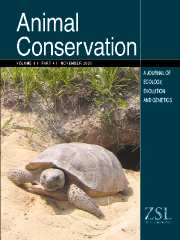Crossref Citations
This article has been cited by the following publications. This list is generated based on data provided by
Crossref.
Shrestha, Rinjan
Wegge, Per
and
Koirala, Rita A.
2005.
Summer diets of wild and domestic ungulates in Nepal Himalaya.
Journal of Zoology,
Vol. 266,
Issue. 2,
p.
111.
Retzer, V.
Nadrowski, K.
and
Miehe, G.
2006.
Variation of precipitation and its effect on phytomass production and consumption by livestock and large wild herbivores along an altitudinal gradient during a drought, South Gobi, Mongolia.
Journal of Arid Environments,
Vol. 66,
Issue. 1,
p.
135.
Bagchi, Sumanta
Namgail, Tsewang
and
Ritchie, Mark E.
2006.
Small mammalian herbivores as mediators of plant community dynamics in the high-altitude arid rangelands of Trans-Himalaya.
Biological Conservation,
Vol. 127,
Issue. 4,
p.
438.
Bagchi, S.
and
Mishra, C.
2006.
Living with large carnivores: predation on livestock by the snow leopard (Uncia uncia).
Journal of Zoology,
Vol. 268,
Issue. 3,
p.
217.
Namgail, Tsewang
Fox, Joseph L.
and
Bhatnagar, Yash Veer
2007.
Habitat shift and time budget of the Tibetan argali: the influence of livestock grazing.
Ecological Research,
Vol. 22,
Issue. 1,
p.
25.
Retzer, Vroni
2007.
Forage competition between livestock and Mongolian Pika (Ochotona pallasi) in Southern Mongolian mountain steppes.
Basic and Applied Ecology,
Vol. 8,
Issue. 2,
p.
147.
Chammem, M.
Selmi, S.
Nouira, S.
and
Khorchani, T.
2008.
Factors affecting the distribution of dorcas gazelle.
Journal of Zoology,
Vol. 275,
Issue. 2,
p.
146.
Schaller, George B.
and
Kang, Aili
2008.
Status of Marco Polo sheep Ovis ammon polii in China and adjacent countries: conservation of a Vulnerable subspecies.
Oryx,
Vol. 42,
Issue. 01,
Shrestha, Rinjan
and
Wegge, Per
2008.
Habitat relationships between wild and domestic ungulates in Nepalese trans-Himalaya.
Journal of Arid Environments,
Vol. 72,
Issue. 6,
p.
914.
Yoshihara, Y.
Ito, T.Y.
Lhagvasuren, B.
and
Takatsuki, S.
2008.
A comparison of food resources used by Mongolian gazelles and sympatric livestock in three areas in Mongolia.
Journal of Arid Environments,
Vol. 72,
Issue. 1,
p.
48.
Namgail, Tsewang
Bagchi, Sumanta
Mishra, Charudutt
and
Bhatnagar, Yash Veer
2008.
Distributional correlates of the Tibetan gazelle Procapra picticaudata in Ladakh, northern India: towards a recovery programme.
Oryx,
Vol. 42,
Issue. 01,
Prins, Herbert H. T.
and
Fritz, Hervé
2008.
The Ecology of Browsing and Grazing.
Vol. 195,
Issue. ,
p.
179.
Escós, Juan M.
Alados, Concepción L.
Pulido, Antonio
Romera, Jordi
González-Sánchez, Nicolás
and
Martínez, Francisco
2008.
Estimating population trends using population viability analyses for the conservation ofCapra pyrenaica
.
Acta Theriologica,
Vol. 53,
Issue. 3,
p.
275.
SHRESTHA, RINJAN
and
WEGGE, PER
2008.
Wild sheep and livestock in Nepal Trans-Himalaya: coexistence or competition?.
Environmental Conservation,
Vol. 35,
Issue. 2,
p.
125.
Odadi, Wilfred O.
Okeyo-Owuor, J.B.
and
Young, Truman P.
2009.
Behavioural responses of cattle to shared foraging with wild herbivores in an East African rangeland.
Applied Animal Behaviour Science,
Vol. 116,
Issue. 2-4,
p.
120.
Namgail, Tsewang
Mishra, Charudutt
De Jong, Christine B.
Van Wieren, Sipke E.
and
Prins, Herbert H. T.
2009.
Effects of herbivore species richness on the niche dynamics and distribution of blue sheep in the Trans‐Himalaya.
Diversity and Distributions,
Vol. 15,
Issue. 6,
p.
940.
Bagchi, Sumanta
and
Ritchie, Mark E.
2010.
Herbivore effects on above- and belowground plant production and soil nitrogen availability in the Trans-Himalayan shrub-steppes.
Oecologia,
Vol. 164,
Issue. 4,
p.
1075.
Chanchani, Pranav
Rawat, Gopal S.
and
Goyal, Surendra P.
2010.
Unveiling a wildlife haven: status and distribution of four Trans-Himalayan ungulates in Sikkim, India.
Oryx,
Vol. 44,
Issue. 3,
p.
366.
Prasad, Soumya
Pittet, André
and
Sukumar, R.
2010.
Who really ate the fruit? A novel approach to camera trapping for quantifying frugivory by ruminants.
Ecological Research,
Vol. 25,
Issue. 1,
p.
225.
Namgail, T.
van Wieren, S.E.
Mishra, C.
and
Prins, H.H.T.
2010.
Multi-spatial co-distribution of the endangered Ladakh urial and blue sheep in the arid Trans-Himalayan mountains.
Journal of Arid Environments,
Vol. 74,
Issue. 10,
p.
1162.


